Cold weapons: plastic knives
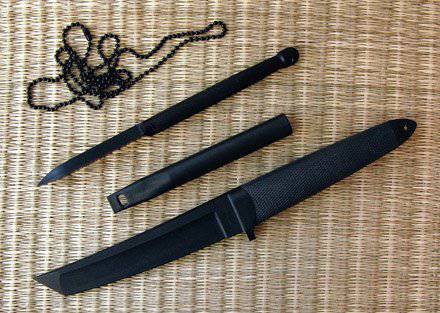
Relatively recently, the very combination of the words “plastic knives” evoked associations only with disposable catering sets and plastic knives for opening envelopes in offices.
In addition, plastic knives were actively used as training for the development of knife fighting techniques. The use of plastic made it possible to switch from wooden and rubber knives, imitating only the general shape of a knife, to dimensional copies of real knives. The use of dimensional copies of real samples increased the efficiency of mastering methods of knife combat and knife manipulations.
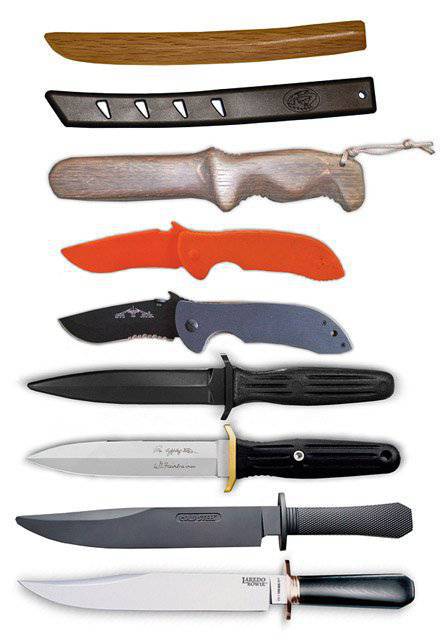
Conventional utility knives and tactical knives were made of steel, although the first stories Knives were made of wood, bone, silicon and volcanic glass.
The achievements of the chemical industry led to the creation of new, fairly strong types of synthetic materials, which were used to make tactical knives and personal defense knives.
For the manufacture of the first plastic knives used plastic type ABS (ABS) and Zytel (zaytel).
The knives made of zatel material had a good piercing ability, but a weak cutting edge. In the future, instead of these materials, more advanced composite materials based on epoxy resins reinforced with carbon fiber (carbon knives) or fiberglass began to be used. These include G-10, Gravory, GPR and MP45. Reinforcement of plastic with glass and carbon fiber allowed for a significant increase in the cutting properties of knives, since micro-tines were formed on the blade due to the fibers.
Leadership in the field of plastic knives belongs to American companies.
In addition, now there are knives made of ceramics, which, by their cutting ability, are almost as good as knives made of steel. However, due to its fragility, until recently, mainly kitchen knives were made of ceramics.
In 1980's The American company Lansky Sharpeners, known for its tools for sharpening knives, has launched a plastic knife for opening packages. For the manufacture of the knife was used thermoplastic ABS.
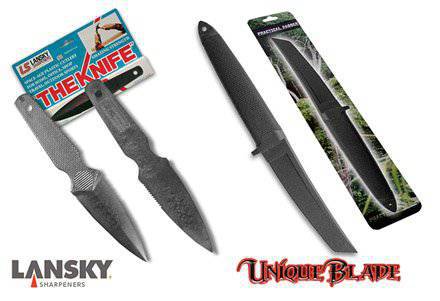
One side of the knife was convex, and the other - flat. To increase the cutting properties of the knife, half of its cutting edge was made in the form of a file of small teeth. It is interesting to note that on the handle there was a so-called "thumbprint", which first appeared on the blade of the famous dagger commando "V-42". The total length of the knife was 17,8 cm, of which 8,9 cm was in the blade. The weight of the knife did not exceed 20 grams.
The operation of this knife has shown that it can also be used as a means of self-defense - the strength of the plastic made it possible to strike a piercing blow, breaking through a layer of clothing.
Union Blade had already made a full-size household knife under the name “Common Dagger” (Practical Dagger) from the same material. The knife was made in the form of a Japanese tanto knife with a blade length of 15 cm, with a full length of the knife - 29 cm.
One of the first material used was a zaytel for the manufacture of knives by the famous American designer of knives EJ Russell (A. G. Russel).
In the middle of the 1970-ies he developed the knife "CIA Letter Opener". Its shape was almost the same as its “Sting 1 A” steel boot knife (boot knife), which was very popular at that time.
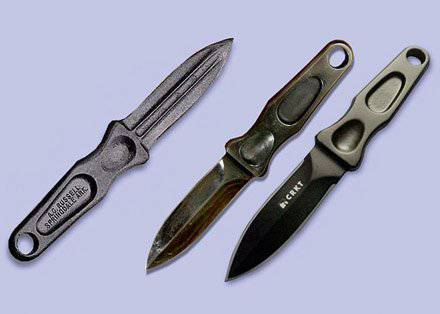
The overall size of the knife was 16,5 cm, and the weight was only about 23 g (the steel equivalent weighed about 110 grams). The stiffeners and the dale on the blade provided strength sufficient for penetration of the wooden plank. For that time, it was the most durable of plastic knives, designed for use in a variety of situations - from self-defense to use as pegs for a tourist tent.
The name of the knife is due to the fact that it was “invisible” to metal detectors. The abbreviation C. I. A. (CIA) in the name of the knife is synonymous with everything related to intelligence and espionage. That is, the name of the knife can be translated into Russian as “Spy knife for opening letters”.
The knife was very popular and served as a model for creating numerous clones with the common name "CIA Letter Opener".
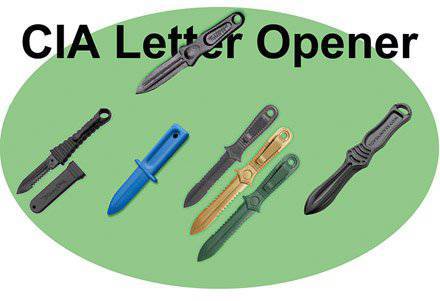
At the beginning of our century, Blackie Collins (Blackie Collins) with the assistance of the company "Shomer Tec" released a new version of the classic "C. I. A. Letter Opener "EJ Russell.
For the manufacture of the knife was used a variety of new polymer Gravory (grevori) - GV3 H, reinforced with fiberglass (60%). The use of this material made it possible to obtain an excellent penetrating ability and a much more durable edge as compared with the prototype knife from the haul.
A micropile appeared on the side of the blade to provide a better cut of the fibrous materials. For the convenience of carrying a knife, a plastic clip is installed on its handle, and the knife has a plastic sheath. In addition, there was a hole for lanyard / lanyard on the handle.
Somewhat different from the traditional form of the knife “C. I. A. Letter Opener "company" Choat Machine and Tool.
Own option “C. I. A. Letter Opener ”is currently being produced by the Israeli company FAB Defense, which specializes in the production of high-quality tactical equipment for the army, police and special units of Israel. This knife has seryettor already on two sides of the blade.
The total length of these knives is 20,5 cm, and the weight of the entire 30 gram. Knives are available in three colors - black, green and olive.
Subsequently, the “espionage” trend was embodied in the Blackjack Knife concealed dagger wearing the OSS Lapel Dagger (it stopped its work in the 1997 year). The company launched the production of a small dagger with a triangular blade, which was a plastic copy of one of the types weapons the last chance of British and American intelligence and saboteurs sent to the territory of Nazi Germany during the Second World War.
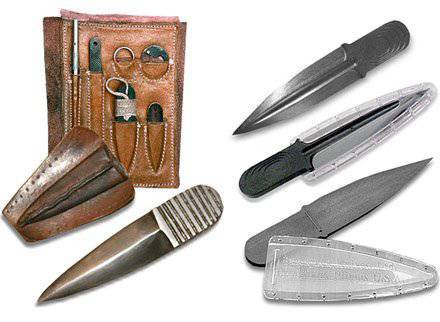
Like its steel prototype, the plastic version could be mounted on the lapel of the jacket's lapels. For this, there were several small holes along the edges of the transparent plastic sheath, using which you could sew a sheath by the cuffs of the jacket’s lapels.
The total length of the dagger was about 9 cm, of which 6 cm is a blade.
Ernest Emerson (Ernest Emerson) was one of the first designers who used G-10 fiberglass laminate to make tactical knives. His tactical knife had a loud name - “A knife for work under a deep cover” (Deep Cover Knife). The knife was designed for police, army and combat swimmers for use in such conditions where the magnetic properties of the knife, electrical conductivity or the possibility of sparks can interfere with the task. The knife was produced by the company "Shomer-Tec".
It was a durable, reliable knife that weighed just 85 grams. The knife could be used as a personal defense weapon, a probe for demining, for digging the ground, or as an improvised spearhead. The use of a new material and its design made it possible to significantly increase the strength of the tip and the cutting edge. The length of the knife was about 26 cm with a thickness of 6 mm. Attached to the knife sheath of nylon, ensuring the carrying of a knife as a handle up and down. The non-metallic clip-clip on the sheath ensured the fastening of the knife on the waist belt.
Subsequently, the Emerson knife was taken as the basis for the “Counter-Terror” knife series of the Mission knives company, which specializes in the development of non-magnetic knives for the army and combat swimmers. The series included four knives of two dimensional categories with a spear-shaped blade and a blade of the “American tanto” type. The main consumer of these knives were divisions of US combat swimmers.
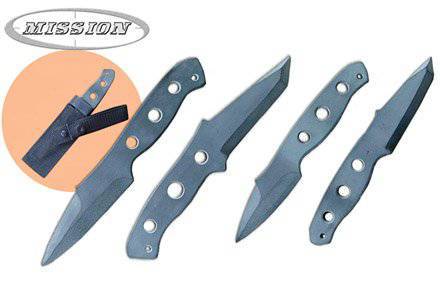
After the cessation of the release of these knives by Mission knives, the knives of the CT-3 model continued to be produced by Mantis Knives for some time in the line of knives under the common name Ghost. This line also included the longest of plastic knives - a machete knife (full length - 35,5 cm). Knives series "Ghost" were completed with nylon sheath.
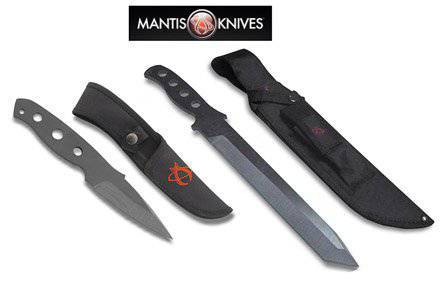
Laci Szabo, a knife-fighting instructor (Laci Szabo), who is known for his original combat and tactical knives, as well as self-defense weapons, developed the GLO Knives series of plastic knives from G-10.
The GLO Knives series of knives includes 6 knives with different types of blades.
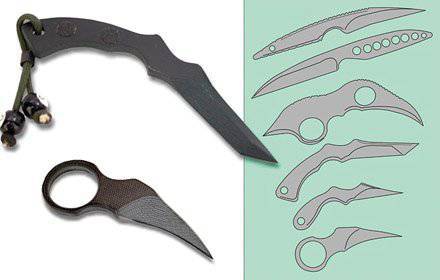
After the events of 11 September 2001, they are sold only to police officers and military personnel.
The company Mad Dog Labs in the development of its plastic knife Frequent Flyer used the fiberglass laminate of its own design, which was superior to G-10 in its strength and cutting properties. Due to the quality of production and well-designed design, this knife was considered one of the best on the market.
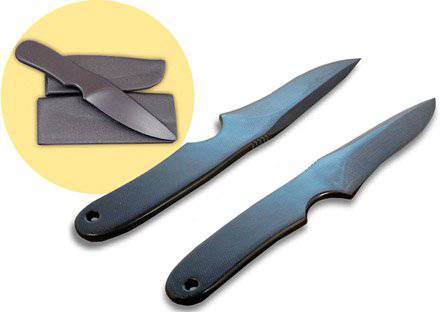
The most durable of all composite plastic knives was the Stealth Hawk knife from Busse Combat Knife Co.
This knife began to be made in 1992 year. For its manufacture used composite plastic "MP45", which has unique properties.
Initially, this knife was developed for the sappers of army units, police and special forces, who had an urgent need for a knife made of non-magnetic material and excluding the formation of sparks when working. In addition, the non-magnetic knife needed and employees of units to combat the spread of drugs, working under cover. When “buying” drugs from drug dealers, the latter often checked them with a metal detector to detect metal police badges or weapons.
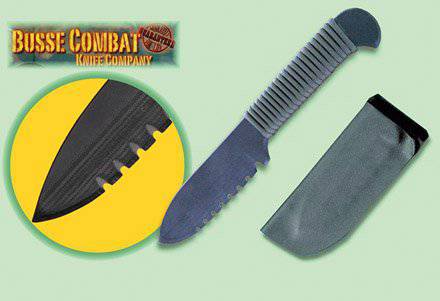
Unlike other companies and craftsmen who chose an existing knife from steel as a prototype of a knife, when creating this knife, the shape of its blade and saw on it was chosen in such a way as to maximize the properties of the source material.
The knife has a specific bullet shape of the tip - “BAT” (Busse Armored Tip), and most of the blade is a seryetor with fairly large teeth. The shape of the teeth is chosen in such a way as to ensure not a cut, but a ripping up of the surface with which they come into contact.
Samples of these knives successfully withstood severe tests of strength, during which car doors were punched with a knife, 200-liter steel barrels were hammered into a wooden bar, and a half-inch hemp rope was sawed into 17 pieces. When clamping a knife in a vice, he maintained bends to 20 degrees without deformation.
Despite these outstanding functional properties, the production of these knives was soon discontinued (currently, “Busse Combat Knife Co” does not produce plastic knives at all). This was due to the complex technology of manufacturing sheets of polymeric material for blanks of knives. In addition, one of the components that make up the plastic was produced by just one small factory, which was closed by the EPA (Environmental Protection Agency) due to harmful emissions into the atmosphere.
Not paid attention to plastic knives and such well-known knife companies like Cold Steel, Fox, Emerson, Boker Plus, etc.
Thus, the Special Steel Department of the Cold Steel Company developed and launched the production of plastic stylets “Delta Dart” and “Knife tanto for undercover work” (CAT Tanto, CAT - Covert Action), made from zatelya.
Delta dart is a triangular stiletto 10 x 10 x 10 mm, length 20,5 cm (blade - 8 cm). The handle with a diameter of 12 mm is knurled. Delta Dart can be equipped with a plastic round sheath (length 13 cm) with a chain for wearing around the neck.
CAT Tanto is an exact replica of Cold Steel's popular steel tactical knife, based on the legendary Japanese knives of tanto and aikutti. Initially, like Delta Dart, it was made from a zatelka.
Subsequently, the company for the manufacture of CAT Tanto began to use more modern and durable material Gravori. From this material was released a whole series of non-metallic knives "Night Shadows" (Nightshades). In addition to CAT Tanto, this series also includes various knives and daggers 9 - from the classic Boot Blade to the exotic Boot Ring, which is a weapon and a multifunctional kunai tool that was part of the ninja arsenal. Most of them are plastic versions of steel knives manufactured by Cold Steel.
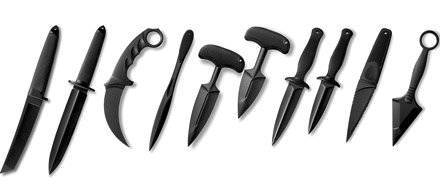
Unlike Delta Dart, made entirely from the same type of plastic, all knives of this series have a coating of handles made of rubber-like polymer material Kraton, which the company uses as a cover of handles from the beginning of 1980's. This material provides a secure grip handles in a variety of temperature conditions, including at high humidity.
Knives of the Granger Knives & Pale Horse Fighters company are considered the best among modern knives in terms of strength characteristics. They are made from new GPR material and are intended for sale to military and law enforcement personnel only. According to the company, the knives are used by federal agents and undercover police operatives. Knives were developed at the end of the first decade of this century.
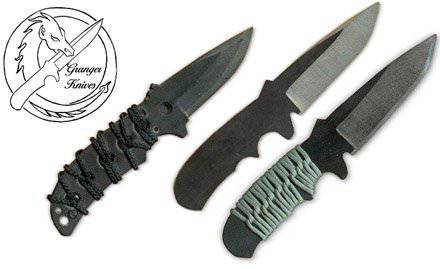
The use of GPR material made it possible to take another step towards increasing the penetration and cutting properties of plastic knives. In terms of hardness of the cutting edge, they are inferior only to ceramic knives and are 4 – 5 times more than G-10 knives, and 2 – 3 times times knives from other polymers reinforced with fiberglass. The hardness of their cutting edge is equivalent to 47 units on the Rockwell scale. When testing a GPR textolite plate with a thickness of 4 mm with a size of 17,8 x 3 cm, it withstood a lateral load up to 113 kg. Since the knives were made of textolite sheets 6 mm thick, their strength was even higher.
GPR knives are available with standard, lateral or combination cutting edge. For the convenience of wearing, they are equipped with a universal kaidex sheath, which provides various options for wearing a hidden knife.
Editing a standard blade can be done with a regular file, and with a standard blade, with a file.
As an example, the photo shows the Granger Knives knives of the GKI 3 and 9 models.
The use of plastic in the knife industry has not bypassed knives like kerambit that have become fashionable at the end of the last century.
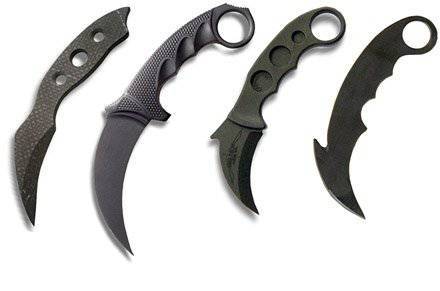
However, the plastic kerabits of the classic design with a sickle blade do not provide the famous ripping cut characteristic of steel kerabs.
Therefore, knives aimed at a thrusting strike with a straight, rather than sickle-shaped blade, but with elements of kerabitite design, ensuring reliable retention of the knife in the hand - handles with a ring (or rings) for fingers, are much more common.
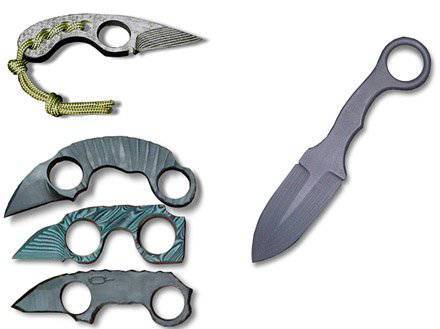
As a rule, the vast majority of plastic knives belong to knives or daggers with a fixed blade. Perhaps the only plastic folding knife was Blackie Collins' knife. The knife was positioned as a knife of personal self-defense, as well as an auxiliary tool for electricians.
As a material for the knife was used zaytel, reinforced with nylon fibers (30%).
Editing the knife can be done with a regular nail file or emery paper.
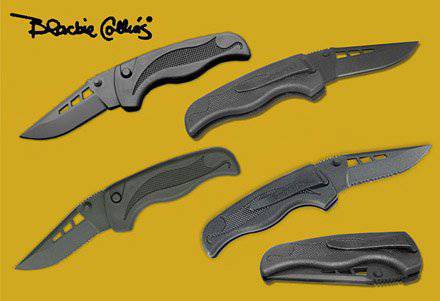
The only metal, but non-magnetic element of this knife was a small beryllium bronze spring, providing a semi-automatic opening of the knife blade. On the handle there was a plastic clip (clip) for comfortable carrying a knife.
The knife was produced with both ordinary and seytorny blade. In the open state, the length of the knife was 16,5 cm, of which 7 cm was in the blade. In the closed state, the length of the knife - 10 cm. The weight of the knife does not exceed 40 grams.
Nevertheless, despite the fact that lately the strength of plastic knives has increased significantly, in their capabilities, they, of course, are inferior to knives with steel blades, especially in their ability to cut. In the best plastic knives, the cutting edge hardness is equivalent to 47 units on the Rockwell scale, while in combat steel knives, this indicator ranges from 58 to 62 units.
These knives are well suited to perform such routine daily operations as opening plastic bags, cardboard packaging, cutting scotch and cords. As for tactical use, then they lose steel blades. They are able to inflict only shallow cutting wounds on the unprotected clothing surface of the body. At the same time, their strength is sufficient to penetrate even rather thick clothing. Knife damage can occur after 5 – 6 impacts. At the same time, the design features of the knife are of great importance, first of all the blade geometry, its thickness, the presence of additional structural elements that enhance the strength of the blade, and the presence of a full-fledged guard.
Therefore, for the purpose of self-defense, plastic knives and jog-type daggers with a knuckle grip, oriented to the prick rather than cut, are most preferred.
One of the first companies on the market was a jog-type knife company called “Choat Machine and Tool” called “Ice of Spades”. The knife is made in the form of a keychain, made of zaytelya.
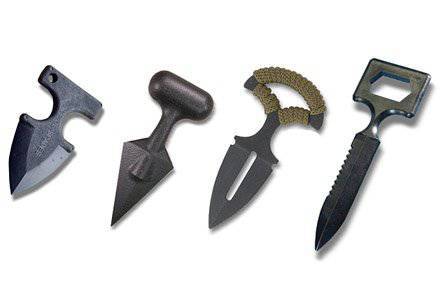
Cold steel push blades from Cold Steel have good combat characteristics. They are based on a series of their excellent jog-type steel knives - Safe Keeper. Push blades are made of Gravior material and are available in two dimensional categories with a blade length of 8,8 (Push Blade I) and 5,7 cm (Push Blade II). Both knives are 6,5 mm thick.
An interesting variant of the “last chance weapon” was developed by the already mentioned Laci Szabo.
This weapon has the unusual name “Covert Straw” and is a carbon fiber tube with a diameter of 7,4 mm with an oblique cut at the impact end. For the convenience of holding in hand, this "straw" has a winding of synthetic cord or tape. In a slightly modified form, its release was adjusted in the United States in three dimensional versions — small with a length of 9,5 cm, medium — 12 cm, and long — 14 cm. Unlike the prototype, a plastic tube with two small rollers is worn on the “handle” of American models for a firm hold of the gun in your hand.
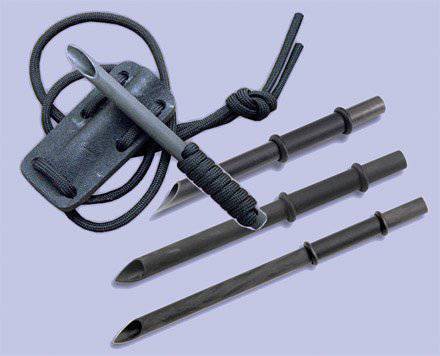
A similar weapon, disguised as a ballpoint pen, was also manufactured by Shomer-Tec.
For women's self-defense on the market you can find plastic combs in the form of knives by Italian designer Lorenzo Damiani, as well as stilettos disguised as a hairbrush (“Cold Steel”) or a comb (United Cutlery).
In the handle of the Cold Steel hairbrush, a stylet is hidden, consisting of two flat blades with the end, forming a single whole and located cross-wise. The thickness of each blade plate is slightly larger than 1 cm. Stylet length - 9 cm. Stylet handle design provides the ability to use any grip.
For the manufacture of the stylet used material zaytel, reinforced with fiberglass.
The total length of this brush with a nested stylet is 21,5 cm, and weight is 2,2 oz.
Stiletto comb “United Cutlery” has a similar design, but is made of polypropylene.
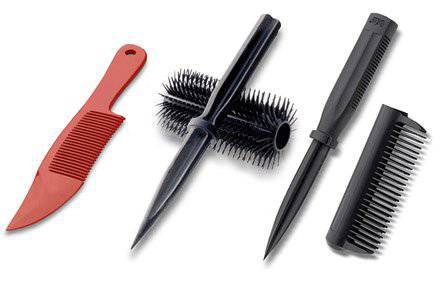
For a long time, plastic knives were perceived by society as nothing more than an exotic toy, especially since the special forces did not particularly spread about the experience of their use by operational staff.
Photos and videos about testing plastic knives, given by manufacturing companies, were perceived as nothing more than a publicity stunt. However, the effectiveness of the use of such knives was also confirmed by independent tests.
The unique property of these knives is that they are not detected by metal detectors. Therefore, they can be freely carried through the framework of these devices installed at airports, in crowded places. Unfortunately, criminal elements also take advantage of this.
After several incidents involving the use of plastic knives, various restrictions have been imposed in the USA. These restrictions were tightened after the terrorist attacks with the capture of 11 September 2001 airliners, when, according to some sources, the terrorists used plastic knives to hijack aircraft. In a number of states, their sale and carrying were banned altogether, many manufacturing companies stopped producing such knives, while others restricted their sale only to law enforcement officers and military personnel.
Some firms began to place small metal plates inside plastic knives in order to make them "visible" to metal detectors. For the same purpose, all Cold Steel plastic knives were sold with a metal ring attached to the end of the handle.
After the tragic events of September 11, the FBI began to collect information about small, easily hidden knives and other similar potentially dangerous objects that may be carried by air passengers in hand luggage or under clothing. Based on the analysis of this information, a special directory was compiled — the FBI Guide to concealedable weapons — the FBI Guide to Concealed Weapons. This handbook has been distributed to X-ray television introscop operators and law enforcement agencies in the United States. The publication contains photographs of dangerous items from the FBI’s point of view that should be withdrawn when flights are found in the cabin of passengers. In order to help identify the items included in the directory, their description is accompanied by photographs of their display on the introscopes screen.
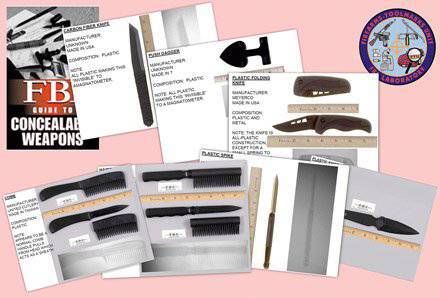
In the future, this guide entered into the free market. Of course, among other things considered to be dangerous items, plastic knives were also included in the handbook: a plastic knife such as Tanto, a small butt-headed dagger with a leaf-shaped United Cutlery blade, a Black Knife Collins folding knife, two knives masked under the United Cutlery hair comb. »UC-732 and UC-2714, Delta Dart stylet, as well as a Lansky opener.
Of the plastic knives listed in the review of the Russian Federation, Cold Steel knives of the Night Shadow series and the Lansky household knife are available for sale.
As already noted, despite the excellent cutting properties, ceramic knives have so far not been notable for shock resistance. However, to date, developed ceramic impact-resistant materials and, as a result, tactical knives made of ceramics.
From our dossier
Polymers - high-molecular substances (homopolymers) with additives added to them (stabilizers, inhibitors, plasticizers, etc.)
Plastics, or plastics - complex (composite) materials based on polymers containing dispersed or short fiber fillers, pigments and other components.
ABS (ABS) - acrylonitrile butadiene styrene, or acrylonitrile butadiene styrene copolymer. Shock-resistant technical thermoplastic resin based on a copolymer of acrylonitrile with butadiene and styrene (the name of the plastic is formed from the initial letters of the names of monomers). The opaque material which is well giving in to coloring.
ABS plastic is widely used in various industries due to its properties - resistance to shock loads, moisture resistance and heat resistance (operating temperature range from - 40 C to + 90 C), resistance to acids, solutions of alkalis and salts. The manufacture of parts from the ABS is produced by injection molding.
G-10 is a kind of fiberglass - a material whose main components are fiberglass and epoxy resins. The production process of the material is a soaking of glass fiber in resins, after which the impregnated glass fiber is compressed. The material has high strength characteristics, moisture resistance, non-flammable, works in a wide range of temperatures and is well-colored. As a rule, it has a characteristic textured and flattened rough surface. In the knife industry it is widely used as a material for the handles of knives.
From our dossier
GRIVORY (Grevory) is a registered trademark of material manufactured by EMS-CHEMIE AG (Switzerland).
Grevori is made on the basis of semi-crystalline technical thermoplastics of polyphthalamide (PFA), reinforced with fiberglass, has high rigidity and strength, weak absorption of moisture, retains its shape well, is resistant to chemicals, thermal conductivity is close to wood.
GPR (Glass-reinforced plastic - fiberglass-based polyester plastic) is a fiberglass made of polyester-based plastic reinforced with thin glass fibers. It has high mechanical strength, resistance to chemicals. The material is fire resistant and retains its properties in a wide range of temperatures.
Carbon fibers (HC) were first obtained by the famous American inventor T. Edison back in the 1880 year. They were used as filament bulbs. However, due to the fact that these threads were brittle, they were soon replaced by tungsten threads.
In the middle of the XX century, on the basis of a new technology, hydrocarbons were obtained, possessing high heat resistance, durability, and resistance to aggressive chemicals. Thanks to these unique properties, HC was used in the manufacture of rocket engines. With the improvement of the technology of manufacturing hydrocarbons and reducing its cost, it has become widely used in various fields as a filler in various types of carbon plastics.
Information